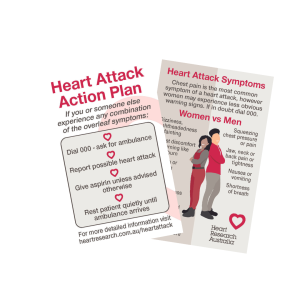
In order to help raise much needed education within the community surrounding women’s heart health, Heart Research Australia organised Dr Monique Watts from Victoria Heart Cardiology in Melbourne to chat with Dr Terri Foran on the HealthEd podcast – Women’s and Children’s health.
Dr Monique Watts is a heart failure cardiologist and specialist in women’s heart disease who works at the Epworth and the Alfred Hospitals in Melbourne. In recent years Dr Watts has established a cardiac clinic in North Central Victoria to improve access to specialist care for rural citizens and has lead the development of the Women’s Heart Clinic at the Alfred Hospital. The Women’s Heart Clinic offers specialised care for patients suffering conditions more commonly seen in women such as the syndrome of MINOCA and contributory causes such as coronary artery vasospasm, spontaneous coronary artery dissection and microvascular dysfunction. In addition Dr Watts is actively involved in clinical research, with multiple current projects in progress in the area of women’s heart disease.
Listen to our webinar with Dr Monique Watts and Alison Daddo on women’s heart health and the role menopause plays here.
Heart disease kills more than two times as many Australian women than breast cancer.
Moreover, about 40% of heart attacks in women are fatal, and many occur without prior warning. Sadly, the majority of women don’t realise it’s one of their leading causes of death.
Heart disease is often less recognised in women, partly because women tend to develop symptoms of heart disease at a much later stage of the illness than men and their symptoms are often vaguer or ‘non-specific’ which can cause a delay in seeking medical attention and lead to more adverse outcomes. To read more about Women and Heart disease click here.
One fact many women are unaware of, is that once they have experienced menopause, their risk of developing heart disease increases significantly to be the same as men.
To hear Dr Monique Watts speak to Dr Terri Foran on HealthEd about Women and Heart Disease, listen below.
To learn what the warning signs of a heart attack are for women, the role menopause plays on a woman’s heart health and what steps you can take before menopause to protect your heart you can watch a video we have created with Cardiologist Dr Ashleigh Dind.
To order a handy wallet card you can keep on hand highlighting the early warning signs of a heart attack for men vs women and what to do should they arise click here.

To read some of the research Professor Gemma Figtree is undertaking to find out why women tend to have worse outcomes than men when they experience a heart attack click here.
